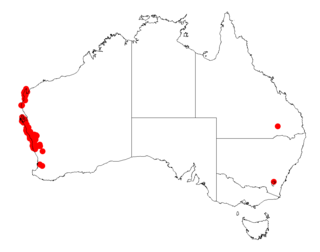
Acacia intorta is a shrub or tree belonging to the genus Acacia and the subgenus Juliflorae that is endemic to arid parts of central Western Australia.

Acacia levata is a shrub belonging to the genus Acacia and the subgenus Juliflorae that is endemic to small arid area of western Australia.

Acacia lirellata is a shrub belonging to the genus Acacia and the subgenus Juliflorae that is endemic to south western Australia.

Acacia oncinocarpa is a shrub or tree belonging to the genus Acacia and the subgenus Juliflorae that is endemic to northern Australia.

Acacia ptychophylla is a shrub belonging to the genus Acacia and the subgenus Juliflorae the is endemic to arid areas of north western Australia.

Acacia richardsii is a shrub belonging to the genus Acacia and the subgenus Juliflorae that is endemic to north western Australia.

Acacia stigmatophylla, also known as djulurd, is a shrub belonging to the genus Acacia and the subgenus Juliflorae the is endemic to northern parts of Western Australia.

Acacia tenuispica is a tree or shrub belonging to the genus Acacia and the subgenus Juliflorae that is endemic to north western Australia.

Acacia dempsteri is a shrub belonging to the genus Acacia and the subgenus Phyllodineae endemic to south western Australia.

Acacia dentifera, commonly known as tooth-bearing acacia, is a shrub belonging to the genus Acacia and the subgenus Phyllodineae that is endemic to south western Australia.

Acacia idiomorpha is a shrub belonging to the genus Acacia and the subgenus Phyllodineae that is endemic to a small area of western Australia.

Acacia spathulifolia commonly known as Gold carpet or the Gold carpet wattle is a shrub of the genus Acacia and the subgenus Phyllodineae that is endemic to coastal parts of western Australia.

Acacia tetanophylla is a shrub of the genus Acacia and the subgenus Plurinerves that is endemic to an area of south western Australia.

Acacia trulliformis is a shrub of the genus Acacia and the subgenus Plurinerves that is endemic to an area of south western Australia.

Acacia vittata, commonly known as Lake Logue wattle, is a shrub of the genus Acacia and the subgenus Plurinerves that is endemic to a small area in western Australia.

Acacia nana, also known as the small red-leaved wattle, is a shrub belonging to the genus Acacia and the subgenus Phyllodineae where it is endemic to eastern Australia.

Acacia quornensis, commonly known as Quorn wattle, is a shrub belonging to the genus Acacia and the subgenus Phyllodineae native to southern Australia.

Acacia striatifolia is a shrub or tree belonging to the genus Acacia and the subgenus Juliflorae that is native to north eastern Australia.

Acacia tenuinervis is a shrub or tree belonging to the genus Acacia and the subgenus Juliflorae that is native to north eastern Australia.

Acacia torulosa is a shrub or tree belonging to the genus Acacia and the subgenus Juliflorae that is native to north eastern Australia.




















